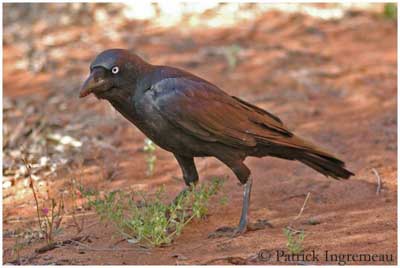
Australian Raven
Corvus coronoides
Passeriforme Order – Corvidae Family
BIOMETRICS :
Length : 48-54 cm
Weight : 500-820 g
LONGEVITY: Up to 21 years
DESCRIPTION:
Australian Raven is the largest member of the crown family.
This bird has shiny black plumage overall. It differs from other raven by longer feathers on throat, named “hackles”. It fluffs them when it’s calling. Body feathers have grey bases.
Strong bill is black. Eyes are white. Legs and feet are black.
PROTECTION / THREATS / STATUS:
Australian Raven is classified as a Declared Pest of Agriculture. They can be shot on private land, if they are damaging crops or stock. That is in accordance with an open season notice, without the need to obtain a damage licence.
But outside the open season area, this licence must be obtained prior to shooting or trapping.
However, in some ways, Australian Ravens help farmers, eating grasshoppers and other pest insects.
Fr: Corbeau d’Australie
All : Neuhollandkrähe
Esp : Cuervo Australiano Grande
Ital : Corvo australiano
Nd : Australische Raaf
Russe : Австралийский ворон
Photographs by Patrick Ingremeau
TAMANDUA
Text by Nicole Bouglouan
Sources:
Birds in backyards (Birds Australia and Australian Museum)
Wikipedia (Wikipedia, The Free Encyclopedia)
Arthur Grosset's Birds (Arthur Grosset)

Both sexes are similar.
Chicks have blue eyes.
Young birds are similar to adults, but they have dark eyes and shorter throat feathers. We can see their pink, fleshy gape.
In their first year, young appear duller in colour than adults. They reach their sexual maturity at three years.
We can find several species of ravens and crows in Australia.
Usually, ravens are larger than crows, and they have grey bases of feathers. Crows have white bases.
Australian Raven (Corvus coronoides) and Forest Raven (Corvus tasmanicus) are the largest species.
Little Crow (Corvus bennetti) is the smallest.
Little Raven (Corvus mellori) and Torresian Crown (Corvus orru) are medium-sized birds.
VOICE: SOUNDS BY XENO-CANTO
Australian Raven utters a slow, high-pitched “ah-ah-ah-aaaah” as territorial call. The last note is very drawn out. It also utters a wailing call, almost as baby-like call.

HABITAT:
Australian Raven lives in varied kinds of habitats, except in the more arid regions. It can be found from deserts through forests, woodlands and scrubs, to pastures. It is common in cities and suburbs such as Perth and Sydney.
RANGE:
Australian Raven is common in eastern, southern Australia, and southern parts of Western Australia. It is absent in the far north.
BEHAVIOUR:
Australian Raven is very shy and flies away when humans approach. They can form flocks of about 30 birds, immature and non-breeding birds, wandering locally or moving further for food.
Breeding pairs are sedentary. They have long-term pair-bonds, usually until one dies. They remain within their territory, but they may perform some dispersion for food, such as grasshopper swarms, carrion and abattoir-waste.

They are very noisy, and become a key-problem when living in cities. They attack other bird species, scavenge in rubbish bins, and damage gardens and vehicles.
In rural areas, Australian Raven damages fruit-crops, but it is an inefficient predator because it prefers carrion and dead animals. It is able to kill small live lambs or other young animals, but only if they are weak or sick.
Australian Ravens are opportunistic feeders. They help themselves to everything from any food source.
Food is taken on the ground, but sometimes in trees.
FLIGHT:
Australian Raven performs strong, direct flight.

REPRODUCTION:
Breeding Australian Ravens live in their territory where nest-site, roost, water and food resources are situated.
Large nest is built in tall tree. It is bowl-shaped or a platform made with sticks, and lined with grasses, barks and feathers.
Female lays 3 to 6 pale green or bluish green eggs, with dark markings. Incubation lasts about 19 to 21 days, by female alone. She also broods the chicks.
Chicks leave the nest about 6 weeks after hatching. After fledging, young are still fed by parents during about 4 months.
This species produces one or two broods per season.

DIET:
Australian Raven feeds mainly on meat, insects, fruits and bread. They find this kind of food in cities and suburbs.
In rural areas, it feeds on carrion, dead livestock and road kills. It also consumes cereals, bird’s eggs and nectar from Eucalypt flowers.
